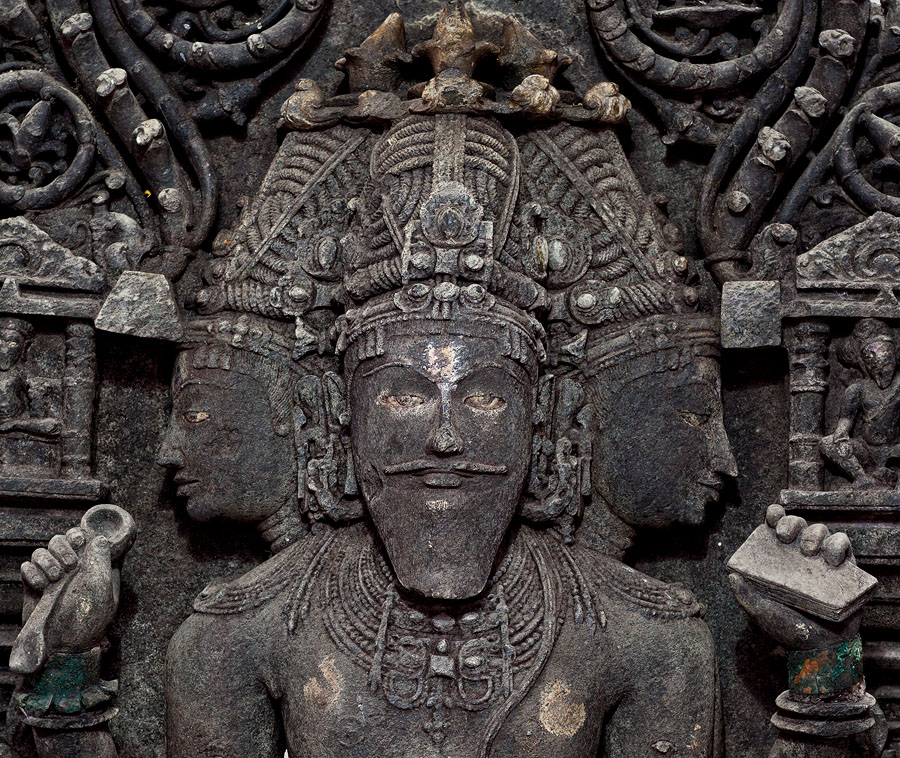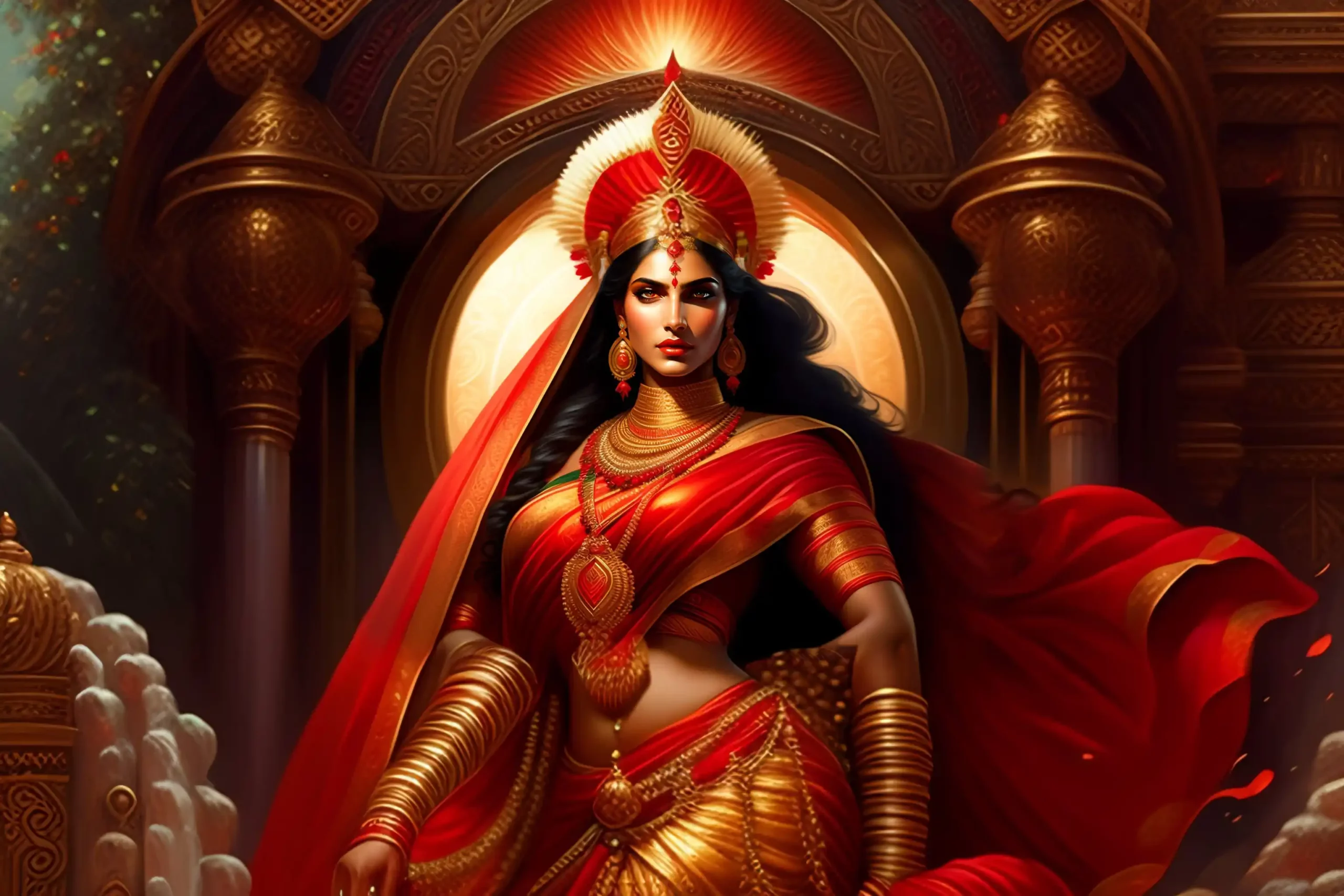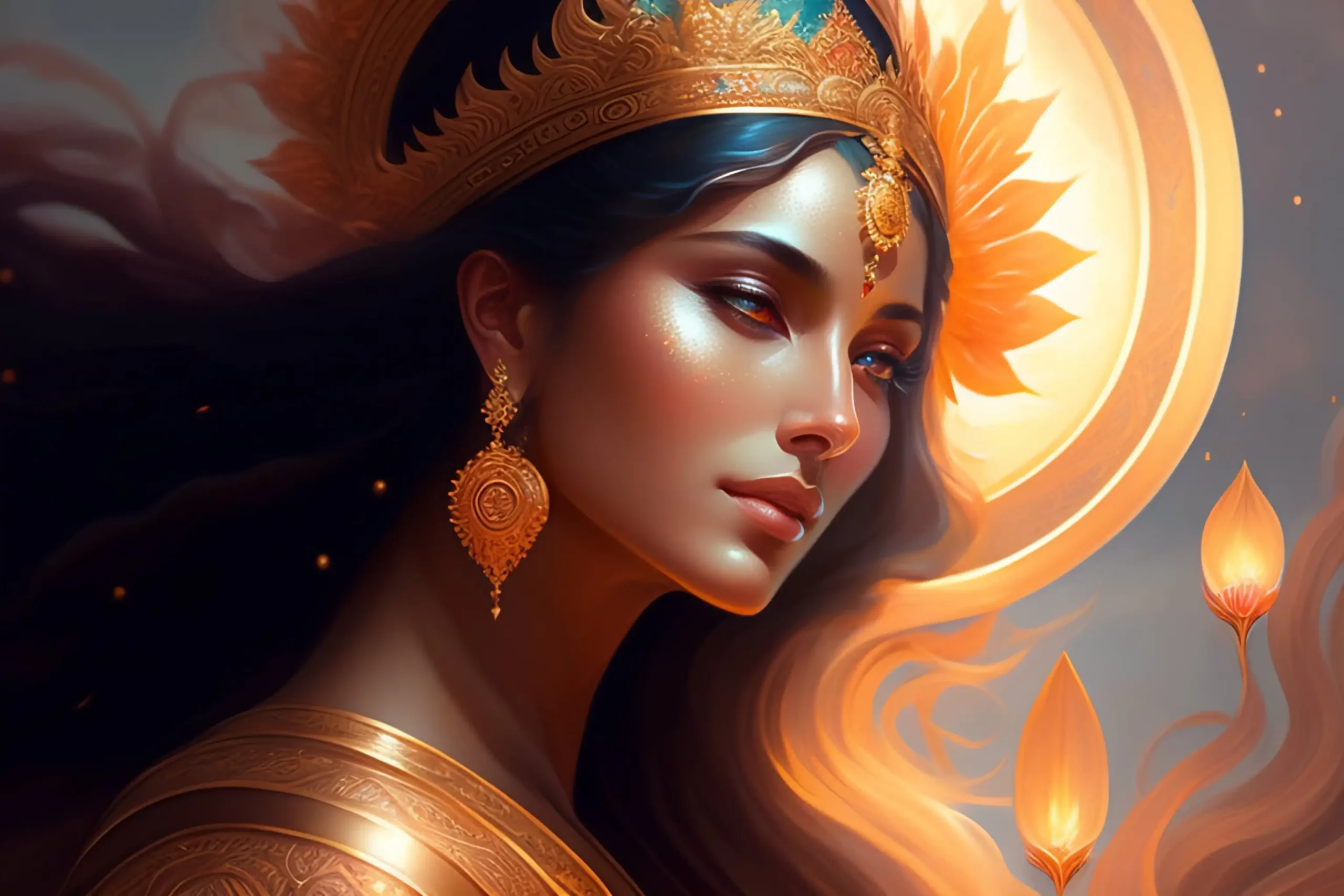The embodiment of intellect and wisdom, the personification of eloquence, and the originator of the greatest music, art, and culture to grace the Earth, Goddess Saraswati is the paragon of virtue and learning. Boasting wit as sharp as her tongue, Saraswati inspires readers far and wide to open their minds to the expansive and enlightening world of knowledge.
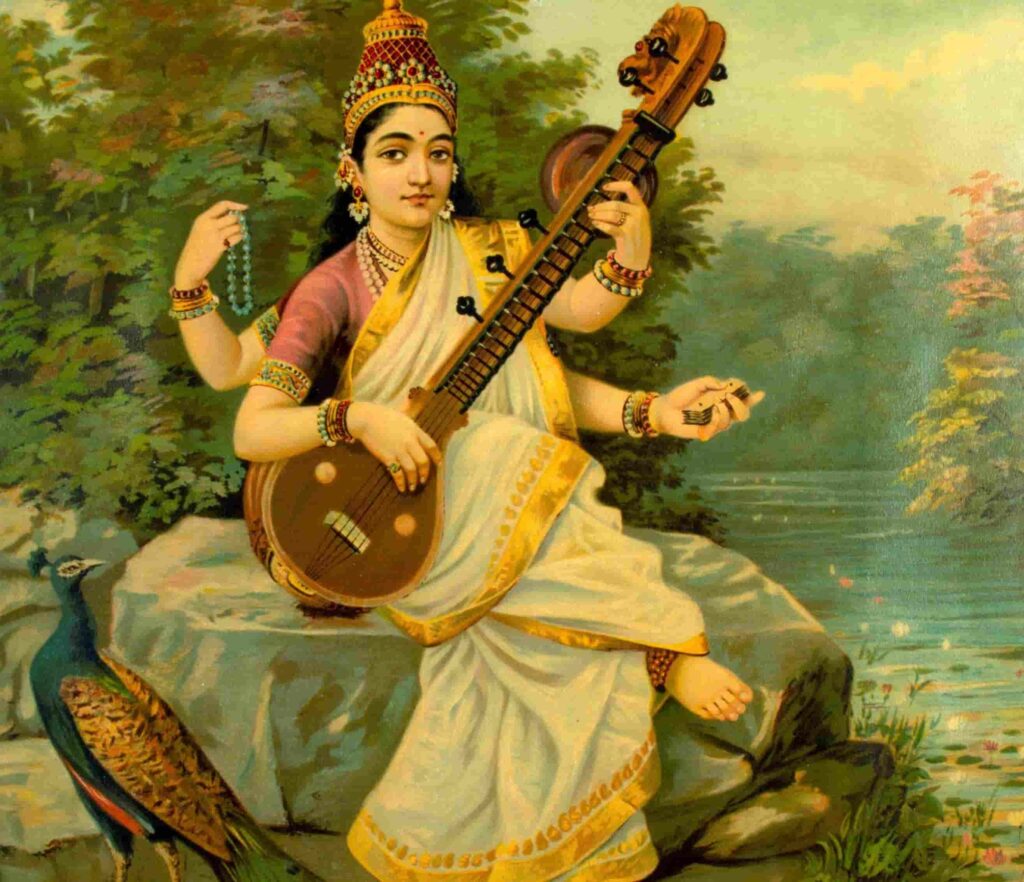
(Public Domain)
Who is Saraswati?
Saraswati (Sanskrit: She who possesses) is one of the Hindu Tridevi Goddesses (The holy trinity of Goddesses comprising Parvati, Saraswati, and Lakshmi) and is the Goddess of knowledge, art, music, and wisdom. Exuding beauty and grace, Saraswati is considered to be the personification of the Saraswati River, flowing with endless knowledge and culture.
Fondly referred to as the “Mother of eloquent speech and melodious music”, Saraswati is the ultimate creative symphony that came into existence when Brahma created the Universe. His spiritual daughter, Saraswati is the manifestation of Brahma’s power and creative energy.
The Goddess of Knowledge, Saraswati is revered as ‘Vedamata’ or the Mother of the Vedas. She is notable for inventing the Sanskrit language and blessing Lord Ganesha (God of Knowledge) with the gift of wisdom, pen, and ink.
Apart from being one of the most significant Hindu deities, Saraswati is widely worshipped in Buddhism and Jainism. In Buddhism, Saraswati is considered to be the guardian deity and the protector of Knowledge.
The patron of knowledge and learning, Saraswati is the physical representation of the purity and evergreen character of nature. Ridding the earth of ignorance, Saraswati dispels chaos and confusion from the world, ensuring that the world functions without any complications. Without Saraswati, the world would descend into disarray, causing widespread pandemonium.
Epithets: Different Names of Saraswati
Goddess Saraswati is known by a vast array of names, each name depicting a unique quality. The name Saraswati itself is derived from the Sanskrit words ‘Saras’ meaning flow and ‘Wati’ meaning woman. Saraswati also means ‘She who possesses ‘.
- Vedamata
Saraswati is known to have created the Sanskrit language, The language of the Vedas- the four ancient holy Hindu scriptures. Consequently, Saraswati came to be known as ‘Vedamata’ which means Mother of the Vedas.
- Shatarupa
Shatarupa is derived from the Sanskrit words ‘Shata’ and ‘Rupa’ meaning ‘Of many different forms. Goddess Saraswati had the ability to incarnate herself into a plethora of different forms, to escape Lord Brahma’s infatuation, earning her the name Shatarupa.
- Vagdevi
Vagdevi is derived from the Sanskrit words ‘Vaga’ and ‘Devi’ which directly translates to ‘Goddess of Speech’. Lord Brahma blessed Saraswati with this title as she is the personification of eloquent speech and sound.
- Bharati
Saraswati was considered to be the most proficient orator, captivating listeners with her speech, hence earning her the name Bharati, meaning Eloquent.
Origin of Saraswati
Saraswati was the spiritual daughter of Lord Brahma and was the first being he created after the Universe. When Lord Brahma created the Universe, he noticed that it lacked creativity and soul. He also observed that it did not have proper structure and form – a matter that was of great concern to him.
In a bid to bring about structure and stability, Lord Brahma created Saraswati, who emerged from his mouth. Brimming with endless knowledge, Saraswati enlightened Brahma, giving him direction on how to create the cosmos – the sun, moon, and stars.
Under Goddess Saraswati’s tutelage, Lord Brahma acquired the ability of speech, thought, and comprehension. He soon began to be able to understand the world around him and began to observe the unbridled potential that lay beneath the chaos that was the Universe.
Saraswati taught Brahma the ancient and melodious Mantras or Chants filled with creative energies. The Mantras of Saraswati and Brahma filled the Universe with ‘Prana’ or ‘Life-force’ and the world began to take shape. Stars filled the skies, and the three worlds began to form – Gods in the celestial world, Humans in the Earth, and Demons in the netherworld.
Hence Lord Brahma created the world with Saraswati as his source of enlightenment, wisdom, and divine knowledge of the Universe, without whom the world would not have taken shape.
Iconography: What does Saraswati look like?
Saraswati is commonly portrayed as a beautiful young woman dressed in all white – symbolizing purity and the search for truth and knowledge. Saraswati is always depicted on a white lotus which symbolizes light, knowledge, and truth.
Saraswati is most commonly depicted with four arms – each arm holding a particular item. Her four hands mirror or complement the four heads of Brahma, Saraswati’s husband. In her four hands, she holds a book, a garland, a water pot, and a veena.

(Public Domain)
- The Book
Saraswati holds a book in one hand, signifying the Vedas which represent all forms of knowledge and learning.
- The Garland
Saraswati holds a crystal garland in her hand which represents spirituality, the power of meditation, and introspection.
- Pot of Water
The pot of water that Saraswati holds in her hand possesses the power of purification, the ability to separate right from wrong, and clean from unclean. It is also symbolic of Soma – the divine drink of Knowledge.
- Veena
Her most notable possession, Saraswati is always portrayed with a Veena – her divine instrument that represents science and creativity. Saraswati’s Veena also represents the interconnectedness of knowledge and harmony and her love for music.
- Saraswati’s Swan
Saraswati is also portrayed with a Swan at his feet. The Swan is a sacred bird and it has the ability to discriminate between right and wrong. It is also symbolic of transcendence and moksha. Since the Swan is her divine vehicle, Saraswati is also known as “Hamsavahini” which translates to “She who uses a swan as her divine vehicle”.
Adopting the swan as her vehicle is exemplary of Saraswati’s strong power of judgment, without being led astray or influenced by the influxes of the world or illusions (Maya) on the road to enlightenment.
- The River
Saraswati is always portrayed next to a flowing river, symbolic of the steady flow of knowledge. It also represents her early life as a river goddess, the manifestation of the river Saraswati.
- Citramehkala
A ‘Citramehkala’ or Peacock is depicted next to Saraswati, a depiction of her creative and cultural side. It also symbolizes the beauty of colour and the elegance and grace of dance and music. The peacock is also the devourer of Snakes, a symbol of the ability to transform the poison of the serpent into the radiance of enlightenment.
Saraswati represents the ‘Sattva Guna’, an attribute of existence that represents positivity, serenity, peacefulness, virtue and balance.
Manifestations of Saraswati
In Various Hindu Sacred Texts, Saraswati is shown to have two main avatars – Maha Saraswati and Mahavidya Nila Saraswati. She is adored as Mahasaraswati in the Kashmir Shakti Peetha, as Vidhya Saraswati in Basara and Wargal, and as Sharadamba in Sringeri. In certain parts, she is known by her twin forms, Savitri and Gayatri.
- Maha Saraswati
Maha Saraswati is the ultimate form of Saraswati, boasting immense power. Maha Saraswati is portrayed as sitting on a white lotus, with eight arms and a Veena. In her eight arms, she holds a conch, pestle, discus, bell, trident, ploughshare, bow, and arrow. She is also described to be glimmering like the moon.
Mahasaraswati is also one of the nine aspects of Shakti – The primordial, ancient Goddess of the Universe.
- Nila Saraswati
Although Saraswati is a compassionate and kind goddess, she also has a violent and angry side that manifests in the form of Nila Saraswati. Nila Saraswati is also a significant goddess in Tantra- an ancient sect of Hinduism and Buddhism that interweaves physicality with spirituality.
Saraswati: The River
Saraswati is considered to be the physical representation of the Sarasvati River, which is widely revered as a symbol of purity. Legend has it that Saraswati manifested herself in the form of a river to save the world from destruction.

(Public Domain)
On one fateful day, a battle of epic proportions ensued between a group of Brahmans known as the Bhargavas and a group of Kshatriyas known as Hehayas. During this fierce battle, a devastating fire called Vadavagni emerged, threatening to destroy the entire world.
Worried about the world’s well-being, the gods turned to Vishnu for help. Vishnu promptly asked Saraswati to take the form of a river and put out the raging fire to save the universe. Saraswati obliged and descended from the celestial realm to Uttanka’s ashram in the Maru desert.
At the ashram, Saraswati met Lord Shiva who contained Vadavagni in a pot and gave it to Saraswati, telling her to merge with the Plaksha tree and originate as a river from the tree. Saraswati immediately complied and merged with the tree and manifested as a river.
The Sarasvati river flowed towards Pushkar and eventually joined with the Ocean. On her path, she extinguished the Vadavagni and saved the world.
Brahma and Saraswati
Saraswati was Brahma’s first female creation and was incredibly beautiful. Exuding youthfulness and grace, Saraswati was a sight to behold – immediately gauging Brahma’s attention.
Infatuated by her beauty, Brahma was determined to take her as his wife. However, this did not sit well with Saraswati, who did not wish to marry Brahma. In the hopes of avoiding his attention, Saraswati often transformed herself into various animals, but to no avail. Brahma would also transform himself into an animal and follow her wherever she went.
To try and avoid Brahma’s gaze, Saraswati began to move in different directions away from him. However, every time she would move, Brahma would grow a new head in the same direction. In this manner, Brahma grew four heads in every direction. In a final attempt to escape him, Saraswati jumped over Brahma, prompting him to grow a fifth head on top of his head.
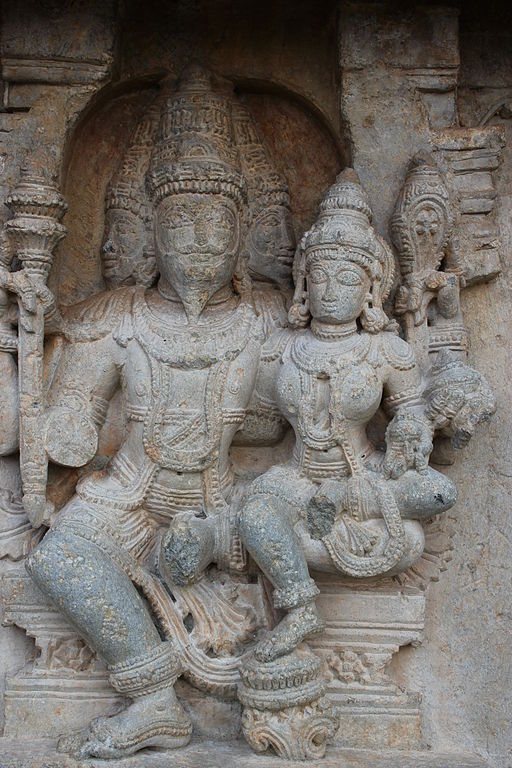
(Public Domain)
Sensing Saraswati’s stress, Lord Shiva grew enraged and appeared in front of them in the form of Bhairava – the god of Terror. In order to teach Brahma a lesson, Bhairava lunged toward him and ripped off his fifth head, subduing his passion.
Shiva then took the form of Ardhanarishvara(Shiva’s half-man, half-woman form) and said to Brahma that men and women are equal, the same souls in different bodies. Sobered by Shiva’s violent attack and his wise words, Brahma turned to Saraswati and asked her to provide him with liberation from his desire.
Saraswati provided him with a divine doctrine of knowledge, instructing him to conduct a Yagna (A traditional fire sacrifice) to cleanse his mind and soul. However, the Yagna required Brahma to have the assistance of a wife and requested Saraswati to marry him.
Impressed by Brahma’s determination to better himself, Saraswati agreed to marry him, thus becoming his eternal wife.
Saraswati: Significance in Hinduism
Goddess of Knowledge and Learning, Saraswati is one of the most widely revered deities in the Hindu Pantheon and has firmly established her position as a household name. Brimming with wisdom and knowledge, Saraswati is the archetypal image of enlightenment.
Devotees worship Saraswati to bestow them with knowledge and awareness and to provide them with the ability to solve tough situations. Children often pray to Saraswati before exams and tests to help them perform well.
Saraswati is particularly celebrated at schools during Vasant Panchami on the fifth day of the fortnight of Magha of the Indian lunar schedule. It is said to be on the birthday of Saraswati.
White, the fundamental colour of Saraswati’s character assumes a critical role on this day. Sculptures of Saraswati dressed in white adorn the hallways as children pay their respects. Saraswati’s birthday is also considered the ideal day for children to begin their academic careers.
In addition to this, Saraswati is the patron of art, music, and dance. Devotees often invoke Saraswati before a performance to guide them and bless them with her divine abilities.
The Sarasvati River was considered to be the most sacred source of water during its prime. Just as the Ganges is considered extremely sacred today, The Sarasvati river was worshipped by devotees. According to the Rig Veda, Sarasvati brings about fertility and life and blesses devotees with health and prosperity.
Festivals Celebrating Saraswati
A vast array of festivals are celebrated annually to commemorate Saraswati and her different forms. These festivals include Vasant Panchami and Navaratri.
Vasant Panchami, also called Saraswati Puja, is a celebration that denotes marks the beginning of spring. Vasant Panchami additionally denotes the last month before Holi, which occurs forty days after. The season and celebration also commemorate the maturing of the crop fields with yellow blossoms of mustard crop, which Hindus believe is Saraswati’s favorite colour.
Numerous families mark this day by sitting with infants and young children, urging their kin to compose their first words with their fingers or sing and dance together. The day prior to Vasant Panchami, The temples of Saraswati are loaded with food so she can join the devotees in the traditional feast the next morning.
Sculptures of the goddess are also adorned in yellow silk, and devotees conduct pujas and austerities to bless their pens, books, and instruments.
Conclusion:
Saraswati is a revered deity who represents knowledge, music, art, and wisdom. Her presence in Hindu culture can be traced back thousands of years and is deeply intertwined with the pursuit of education and self-improvement. She is worshipped by students, artists, and intellectuals, who seek her blessings in their respective fields. Her image and teachings continue to inspire people to strive for excellence and seek the truth through education and wisdom. In today’s world, the message of Saraswati is just as relevant as it was thousands of years ago.


